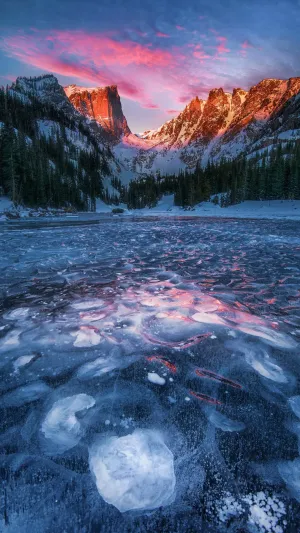As temperatures plummet, the tranquil surface of lakes undergoes a remarkable transformation, freezing over to create a breathtaking winter spectacle.
Lakes freeze differently from rivers, owing to their relatively stable nature. Despite surface turbulence caused by wind and waves, the depth of the water remains stable, facilitating the gradual cooling of the lake water during winter months.
As temperatures drop, the cooler water sinks while warmer water rises, inducing convection until the water temperature reaches 4°C, where the highest water density is achieved. Subsequently, heat conduction becomes the primary cooling mechanism, maintaining the lake's deep-water temperature at approximately 4°C.
In the absence of turbulent flow, lakes experience surface supercooling, where water freezes rapidly if conditions are calm. The process initiates with the formation of small flake ice crystals on the water's surface, which gradually expands into a frozen shell encapsulating the lake overnight. The thickness of the ice cover determines its suitability for various activities, with a 5-centimeter thickness permitting pedestrian passage, a 20-centimeter thickness accommodating skaters and horse-drawn sleds, and a thickness exceeding 50 centimeters allowing for vehicular traffic through ice channels.
Navigating safely across frozen lakes requires vigilance and preparation. Before venturing onto the ice, individuals must assess its thickness and condition, ensuring it can support their weight. Non-slip snow boots enhance traction, while wrapping footwear in cotton or linen cloth provides additional friction, reducing the risk of slipping.
Several factors influence the freezing of open water bodies, including temperature, water volume, water depth, and salinity. In regions characterized by low temperatures, such as high latitudes or altitudes, or areas affected by winter monsoons, rivers and lakes are prone to freezing. Smaller water volumes and shallower depths facilitate freezing, while higher salinity levels lower the freezing point of lake water.
Temperature differentials between air and water initiate the freezing process, with water bodies beginning to lose heat when temperatures drop below 0°C. Factors such as specific heat capacity and land temperature also influence freezing patterns, with water along the shore freezing more readily than in deeper central areas.
Salinity plays a crucial role in determining the freezing point of lake water, with higher salinity levels lowering the freezing point. Salinity distribution in lakes follows geographic patterns, with subtropical sea areas exhibiting lower salinity levels compared to high-latitude regions.
The freezing of lakes represents a fascinating interplay of environmental factors, transforming serene bodies of water into captivating winter landscapes. Understanding the mechanisms behind lake freezing enhances our appreciation for the intricacies of nature's seasonal transitions. As we marvel at the beauty of frozen lakes, let us also embrace the opportunity to explore and engage with the wonders of our natural world.





